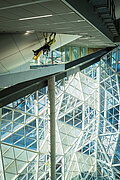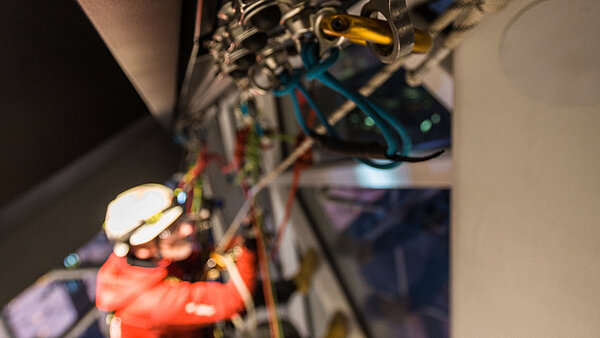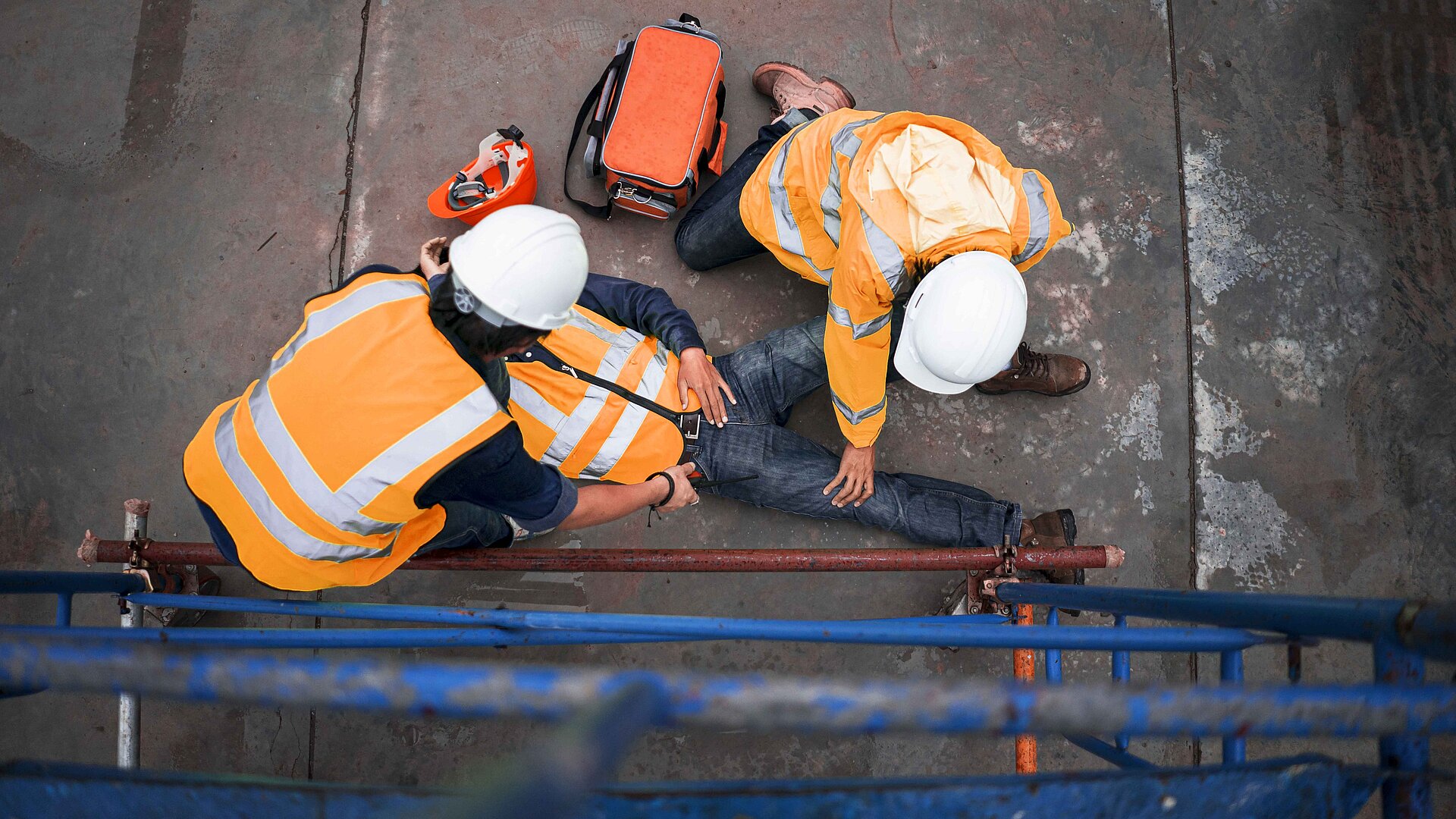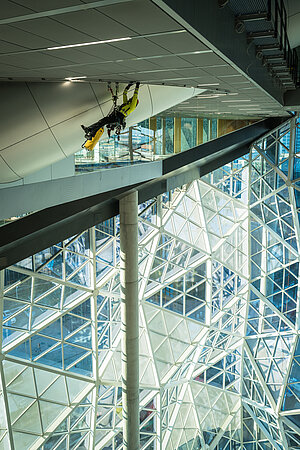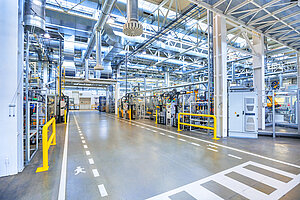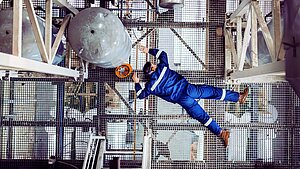In industry, fall protection is nothing new. However, situations of the illusion of safety continue to occur, and on occasion these can have serious consequences for the employees as well as the company. Safety systems applied, for example, to robots, vehicles, cranes, machinery, and plant, are certainly safely planned and installed to individual requirements. However, in addition to special equipment, PSAgA (personal protective equipment against falls), rescue systems, and expert training also form part of a holistic concept for maximum safety at work. In our general overview, you will now read what fall protection is, why it has to be professionally implemented in industrial operations, and what costs, legal principles, and process steps are involved.
What is fall protection?
As the word states, fall protection “protects” people from a “fall”. Strictly speaking, it refers to a safety system, generally in the form of installed equipment, and in a broader sense it refers to a holistic safety concept which ensures the best possible “in situ” safety in every situation. In addition, a distinction is made between:
- Primary fall protection: prevents a fall in danger areas
- Secondary fall protection: protects users and materials in the event of a fall
- Personal protective equipment(PPE): individually fitted equipment items for the user, e.g. fall arrest device, helmet, or harness.
The ASR regulations (technical regulations for workplaces) in Germany define fall protection as “intrinsically effective equipment which impedes a fall even without the conscious participation of the worker [...]”.
Why are fall protection systems necessary in industry?
Understandably, most people think of tall cranes, buildings, or roofs, where fall protection is necessary and obviously sensible. But in fact, even at low heights of 2 metres, a fall can have disastrous consequences for the victim. This is why, for example, regulation 5.2 Abs.2 ArbStättV in Germany provides that, excluding certain exceptions, fall protection is necessary for heights of 2 metres and more. In industry, fall protection systems are therefore required wherever danger zones exist because of heights, inclinations, and/or edges. This applies, for example, to tasks on machinery and plant, on poles, in works halls, along the walls of halls, and in many more cases.
Professional safety systems and holistic safety concepts comprehensively protect the user from falling, and at the same time protect all materials and/or machinery from costly outages, caused e.g. by falling objects. An overview of the industry/manufacturing application area and its fall protection systems can be discovered here.
Which legal foundations apply to fall protection in industry?
There is no single set of regulations for fall protection in industry. However, various laws and legal principles govern the implementation of safety concepts in industrial companies in Germany, Austria, and Switzerland:
- Relevant laws:
Act on workers protection (ASchG), Regulation on personal protective equipment (PSA-V) and Regulation on machinery safety
- Further legal principles:
DGUV regulations in Germany, SUVA in Switzerland, various European standards (EN 362, EN 363, EN 795, EN 353, etc.)
Liability for fall protection systems in industry fundamentally rests with the owner and/or the primary responsible leadership of the operation. However, in the event of a fall, it is necessary to clarify whether misconduct occurred on the part of the (internal or external) responsible safety experts, the installation company, the manufacturer, or of the affected user himself/herself.
How do industrial operations achieve real fall protection?
Although fall accidents cannot be completely avoided, industrial operations can nevertheless do much to avoid them as far as possible. For this, a holistic safety concept has to be planned and implemented. This consists of 6 essential steps:
- Testing the substructure: To be able to select the appropriate products, the substructure to which the fall protection system will be attached will have to be inspected. This is the only way for those responsible to determine the optimum system and the appropriate fastening materials.
- Planning: After selection of the correct anchorage devices, a specialist in fall protection systems plans the intended safety system down to the last detail and holds discussions with other specialists where necessary.
- Installation: A certified fitter implements the final fall protection concept, on the basis of detailed installation instructions and product descriptions. Real fall protection can be ensured only if the supplied and tested materials are used exclusively.
- Documentation: Because the documentation of the fall protection system is legally prescribed and forms the basis of the annual inspection, it must be performed meticulously and completely. This includes installation and acceptance logs, in addition to images.
- Personal protective equipment against falls from a height: Personal protective equipment against falls from a height consists not only of individual element such as helmets, harnesses, or cables, but also of regular PPE training sessions. This is because only certified specialists may use the fall protection system.
- Rescue measures: Because a suspension trauma of only 20 to 30 minutes can result in loss of consciousness or, in the worst case, in the death of the victim, a sustainable rescue concept is an essential component of true fall protection in industry.
How does the illusion of safety arise in industrial operations?
There can hardly be an industrial operation where there are no safety precautions against falls. However, if these are not based on a sustainable and holistic safety concept, the risk of an illusion of safety quickly arises. In such a case, the safety measures taken are insufficient or even incorrect. For example, although a highly professional safety system is installed, there is no suitable rescue plan. Or else, instead of the original fastening materials, the fitter used similar items from a hardware store which had not been approved in advance by the safety system manufacturer.
How can the illusion of safety be avoided?
The illusion of safety can be avoided by means of the STOP principle:
S = Substitution: Substitution of sources of risk, e.g. toxic cleaning agents are replaced by neutral agents
T = Technical industrial safety measures: The use of high-quality, approved products, e.g. cable and rail systems, scaffolding, anchor points
O = Organisational industrial safety measures: Measures within the organisation, e.g. access restrictions or regular employee training sessions
P = Personal industrial safety measures: Personal protective equipment, including PPE training sessions, e.g. safety shoes or gloves
What is the cost of a fall protection system in industry?
The scope and costs of a fall protection system depend on the individual requirements of the respective industrial operation and/or the risk situation which has to be secured. Overall, the following cost items may be expected:
- Planning and services:
The safety equipment and the safety concept are planned once only, but are also linked to ongoing service costs, such as employee training or annual inspection by certified assessors.
- Installation:
For the installation of the fall protection system, on the one hand investment costs arise for the materials of the safety system, and on the other hand for the calculated working hours of the fitter. Here, costs can be saved with products which are easy to install, because they allow rapid installation and documentation.
- Documentation:
The documentation of the fall protection system also creates costs based on the working hours of the person who performs this. This can be the fitter responsible, an independent inspection (TÜV) and civil engineer, or another certified expert. Digital solutions, such as documentation software help significantly to reduce these costs.
- Servicing & repair:
The costs of servicing & repair depend on the size and scope of the industrial operation’s fall protection system. This is where things like cable lengths, additional items, and insufficient documentation with undesired consequential costs are decisive.
Basically, the truth is that a sustainably planned and professionally implemented fall protection system has greater long term benefit than quickly installed standard solutions having, initially at least, lower procurement and investment costs. In addition, a partner with many years of experience is able to develop cost-effective solutions and to minimise the risk of unforeseen consequential costs as far as possible.
Why is a fall always more expensive than a fall protection system?
DGUV Report 1/2013 Calculation of the international“Return on Prevention” for Companies came to the conclusion that an appropriate and effective fall protection system is cheaper in the long term than a fall. The reason for the positive prevention balance is in particular the high predictability created by a holistic safety concept, as against the barely predictable consequences of a fall accident:
Cost-creating consequences of a fall:
- Non-calculable downtimes caused by slight to severe injuries after a fall
- (Temporary) employment of an additional specialised employee
- Possible halt of equipment or machinery damaged during a fall, possibly because of falling parts, tools, etc.
- Risk of threatened penalties for negligent conduct without sufficient safety measures
- Far-reaching consequential costs caused by loss of image or damage to employer branding
Definition(s) of a fall:
Different institutions define a fall in different ways. The following two definitions are relevant in industry:
- Definition by BAUA (German Federal Institute for Occupational Safety and Health): Falling onto a surface or object at a lower level, breaking through a non-supporting surface, and/or sliding uncontrollably over a fall edge when working on inclined surfaces.
- Definition by WKO(Austria): An industrial accident which results in certain obligations for the service recipient and for the service provider, such as reporting an accident, obligation to keep records, and assessment of events related to an accident.
The best way to avoid a fall and its related costs is through industrial operations, together with an experienced partner, developing solutions which are appropriate and effective from A to Z, and are tailored to the individual requirements. For this, both versatile standard solutions and specifically developed special solutions are available.
What are special solutions?
The planning and implementation special solutions are necessary where the use of standard products is unable to provide a true fall protection system. Instead, specially developed safety systems and concepts which fulfil very particular requirements are required. In industry, these special solutions are frequently required because, for example, chemical substances are in use which would attack the material of products which are used as standard. Typical special solutions in industry include:
- Fall protection for machinery
- Fall protection for cranes and crane runways
- Fall protection for ascents
How do you find an expert partner for fall protection in industry?
- Find out the experience and expertise of the provider or manufacturer of fall protection systems for industry.
- Here, you should pay attention to proposals for special solutions.
- Make contact, in order to find out whether you are listened to as a customer.
- Set value on a partner who uses only approved products.
- In your discussions, note from the very start whether it’s more about sales or in fact about safety.
- Ask the provider about legal standards, in order to determine how expert he is in dealing with these.
- Rely on a partner who himself offers training sessions, because this represents know-how and specialist knowledge.
Summary: Fall protection in industry needs to be considered holistically
In the end, the purpose of every fall protection system is to save lives. Risking a fall does not pay, either in terms of safety or costs. Instead, a holistic, sustainable safety concept provides the best possible benefit for every industrial operation. You can read all relevant information and tips from experienced professionals in our free manual of fall protection in industry. In addition, you will find an excerpt on the application area Industry/manufacturing about the areas at risk of falling and possible safety solutions for them. Machine safeguarding, for example, can be done with the BARRIER guardrail system. But also the rail system TAURUS-ALLROUND and the AIO-LIFELINE-SYSTEM-PASSABLE in combination with the PPE-STRING provide a remedy in this area.






